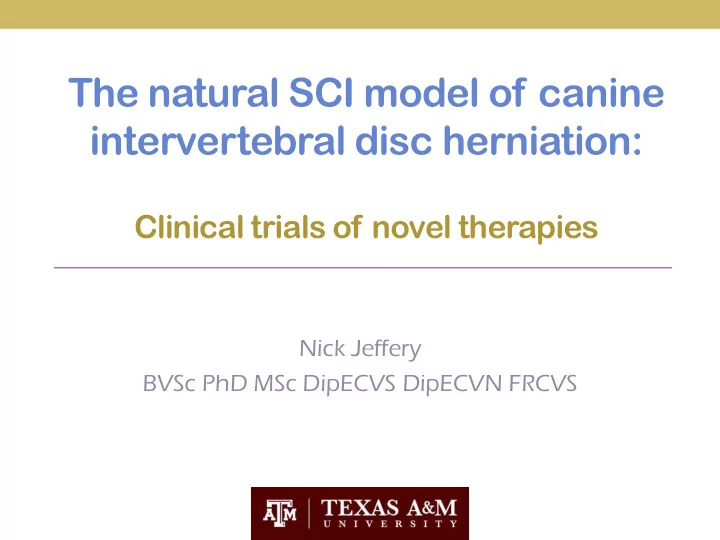

The natural SCI model of canine intervertebral disc herniation: Clinical trials of novel therapies Nick Jeffery BVSc PhD MSc DipECVS DipECVN FRCVS
Why clinical dogs? Increase confidence to translate from laboratory to clinic
Dogs are amenable to detailed locomotor assessment Normal dog Injure red d dog
… electrophysiology … TMMEP SSEP
… bladder function … Normal dog Fowler et al, 2008 SCI dog Detrusor over-reactivity
… high quality MRI…
Clinical veterinary thinking on dogs Our patients are Rat ather er Large rats tha han n small(ish) humans
‘Necessary’? • Use for determining effects in actual clinical condition
Heterogeneity: dog patients vary similarly to their human counterparts… Variability iability in: age, weight, lesion nature, severity, intercurrent disease, genetics…. … which makes detection of beneficial effects more difficult … but more clinically- relevant … Clin inica ically: lly: Is the intervention sufficiently efficacious to make a meaningful difference to a recipient?
Aim: unbiased measure of intervention effect in chronic clinical canine SCI using an RCT Recruit cases of chronic (>3 months from injury) clinically complete SCI Randomization Treatment Control Blinded assessment of primary and secondary outcome measures Pre-defined primary outcome measure = fore-hind coordination
~15- 20 years ago… Lancet Neurology 2006
Trial case selection T3-L3 T3 L3 C1-C5 C1 C5 • Clinically ‘complete’ injury C6-T2 C6 T2 L4-S3 L4 S3 • Recovery at a plateau ( i.e. >3 months after SCI) • Thoracolumbar lesion • Small dogs • Usin ing g very seve vere chronic nic case ses s minimiz nimizes es re required ired sample le size ze
Blinded observer correctly identified 78% transplanted animals • LR test: P = 0.04
1 month 2 months Cumulative delay (ms) 3 months 4 months 6 months
OEC transplant significantly improves fore-hind coordination Cont ntrol OEC P = 0 0.007 Distribution-based calculation (mean change /s.d.) = 0.955 - designated a ‘large effect’ (Cohen, 1977)
S PIN - OFF QUESTIONS FROM OEC TRIAL What is the best method for cell transplantation? How long What’s the do cells best time to survive? transplant? Should we transplant more than once??
Randomized double-blinded phase II clinical trial of intraspinal chondroitinase ABC in dogs
Why chondroitinase? • Long history of success in multiple laboratories and multiple species Bradbury et al, 2002 : • Translatable delivery system: Heat-stabilization by trehalose and slow release from lipid microtubes (Lee et al, 2010) • Synergistic with physical therapy: Garcia-Alias et al, 2009 • Can use sham injection for controls
Methods Inject under anesthesia at 2 sites: lesion epicenter and cranial margin of central pattern generator lower motor neuron network - 200 m L at each site (=625mU) OR Needle puncture of skin
Demographics: chronic disease in middle-aged animals Chondroitinase Control Age (year) Median (range) 6.0 (0.5 – 14) 6.0 (1 – 13) Weight (Kg) Median (range) 6.3 (2.7 – 20) 6.0 (2.2 – 17) Time interval since injury Median (range) 10.5 (3 – 75) 17 (3 – 89) (months)
Results: primary outcome - coordination As a group, ChAse dogs have improved coordination 23% improvement from baseline Significant interaction between time and ChAse: P=0.007
Results 3 individual dogs recovered to walk independently
Results: von Frey filament skin sensitivity testing • Very variable but median score of zero at all time points • Increase in scores after injection … in BOTH groups • Fading of sensitivity with time, final results similar to baseline
Results: other adverse events Contr trol l (8) Treatmen tment t (11) Mont nth h 0 1 1 – diarr rrhea 1 1 – acted painful nful for 12 hr hr 1 1 – seizure re when recovering ring from GA 1 1 – diarr rrhea 3 3 – reduced d movement nt for r 1-3 days Mont nth 1 1 – skin ulceration 1 tion 1 1 – skin ulceration tion 1 1 – diarr rrhea 1 1 – spasms ms in pelvic ic limbs bs 1 1 – diarr rrhea Mont nth 3 1 1 – diarr rrhea 2 2 – UTI 1 1 – UTI Month 6 1 1 – hematuria ria None 2 2 – UTI
Obstacles to translation – where are these therapies now? • Safety • Second species confirmation? • Can delivery system be translated? • Resilient in the face of clinical heterogeneity?
Clinical dog cases can’t solve everything • Can’t get verbal feedback on pain etc • Can’t evaluate fine motor function (CST) • Some limits on possible interventions (and follow-up)
Remaining translational questions • What is the relationship between spinal fracture in a car crash and acute disc extrusion in a dog? VERSUS US Kaufman et al, 2013 http://www.sci-recovery.org/sci.htm
Ethical aspect • Using clinical cases avoids inducing the target disease • BUT • If a dog therapy is not the outcome then we are effectively using them as tools to develop human medicine where they may be harmed but accrue no gains
Where do we go now? • Do a human clinical trial! • Increase effectiveness of interventions • Better delivery • Greater activity of cells or enzymes • Make a commercial product for dogs
Acknowledgements Ravi Bellamkonda Hilary Hu Georgia Tech / Duke Texas A&M Nicolas Granger Bala Pai University of London Georgia Tech
Recommend
More recommend